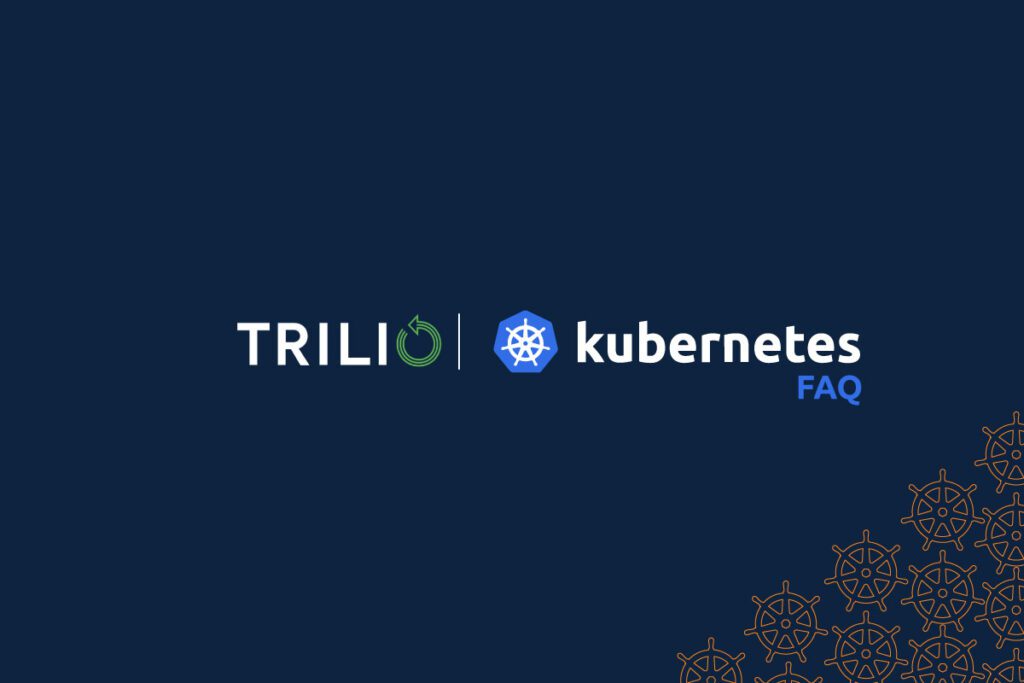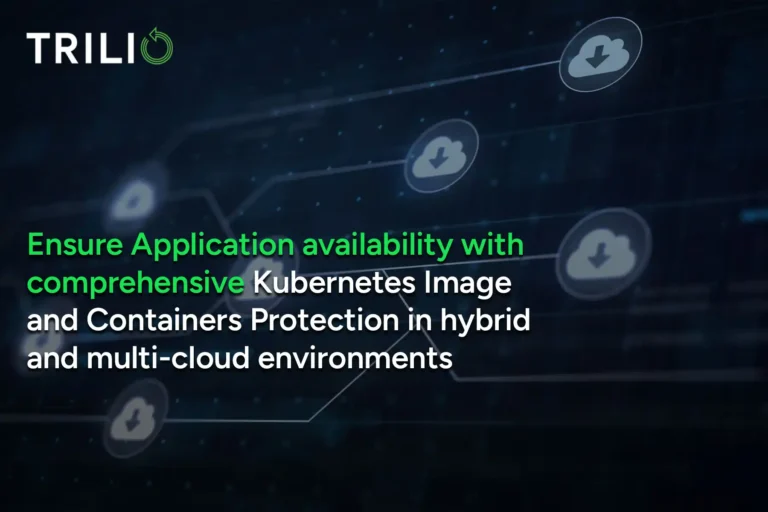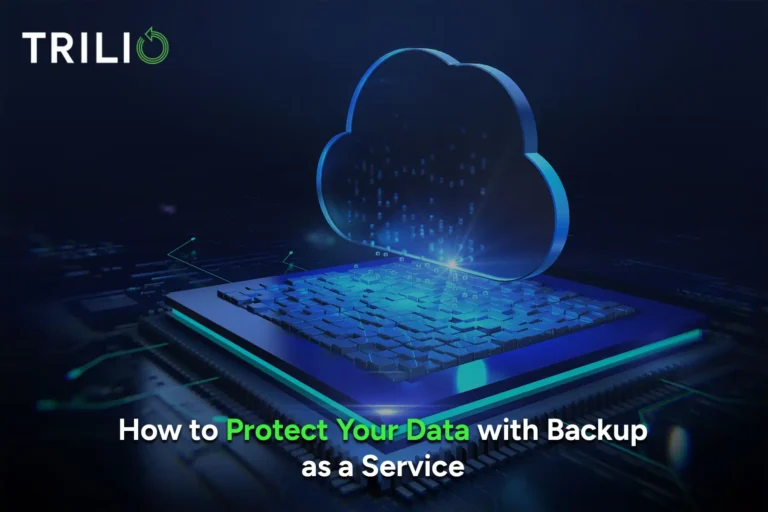Intro
Hi all! I am Rodolfo. I have been working in IT for more than 25 years, since Solaris 2.6, and I’ve seen a lot of changes on the industry. Can you imagine the difference between Solaris 2.6 and Kubernetes? How things were managed then and how they are managed now?
My latest roles have been Red Hat Instructor, which I’ve been since 2014, OpenStack consultant in a large UK telco, and in July 2020 I joined Trilio, a data protection startup, probably the most demanding and at the same time thrilling job of my life.
Since I joined Trilio in July 2020, I can’t say how many introductions of our products I have made to our prospects and then customers. And I thought, hey, why not creating a FAQ that can be updated with new questions from time to time? Yes, I usually get questions that are the same over and over, or very similar. Certainly they change over time, and you would ask “why?”…Simply for the reason that as our product is constantly changing, evolving, and having new features, my talk track changes, so questions change slightly over time. But many of the questions and answers I am going to present here, are totally relevant today…
I have divided the FAQ in two sections, one more generic about Kubernetes backup, and another one which I believe is more technical, and Trilio oriented…
This blog post is a culmination of real-world questions and concerns raised by prospects and customers like you. Whether you’re just starting with Kubernetes or are a seasoned administrator, this guide will equip you with the knowledge to protect your valuable data and applications configuration.
I’ve carefully crafted this FAQ based on insights gained from demos, presentations, and sales interactions. It’s designed to address your most pressing questions about Kubernetes backups, from the fundamentals to advanced strategies and answering some technical common questions.
Generic Kubernetes Backup Questions, included here to help you start with Kubernetes backups
A: Kubernetes backups are copies of your containerized application data, metadata and images, that can be used to restore your applications in the event of data loss or corruption.
A: Kubernetes backups are important because they protect your valuable data from loss. Containerized applications are becoming increasingly popular, and with this popularity comes the need for robust data protection.
A: There are three main types of Kubernetes backups: snapshot backups, crash consistent backups, and application-consistent backups.
Snapshot backups create point-in-time copies of persistent volumes (PVs) within the Kubernetes cluster.
Crash-Consistent backups capture data as it is, without quiescing the application or database, and backup is moved far from the cluster.
Application-Consistent backups ensure that all components of an application are backed up together in a consistent state, and backup is moved far from the cluster.
A: The best Kubernetes backup strategy for you will depend on your specific needs and requirements. Some factors to consider include the type of data you are backing up, your application requirements, and your desired recovery time objectives (RTOs).
A: Implementing a Kubernetes backup solution typically involves several steps:
Choosing a backup tool: Select a backup tool that aligns with your backup strategy and supports your Kubernetes environment.
Configuring backup policies: Define backup policies that specify the frequency, retention period, and scope of backups.
Integrating with storage infrastructure: Integrate the backup tool with your storage infrastructure to store backups securely and efficiently.
Scheduling and monitoring backups: Schedule backups to run automatically and monitor backup jobs to ensure successful execution.
Testing and validation: Regularly test backup and restore procedures to verify data integrity and ensure effective recovery in case of emergencies.
A: Here are some best practices for Kubernetes backup and recovery:
Implement the 3-2-1 Rule: Maintain at least three copies of data, stored on two different media, with one copy kept offsite.
Regularly verify backups: Validate backups periodically to ensure data integrity and prevent undetected corruption.
Test restore procedures: Conduct regular restore tests to ensure the ability to recover data in case of incidents.
Automate backup and recovery processes: Automate backup and recovery processes to minimize manual intervention and ensure consistency.
Stay updated with Kubernetes and backup solutions: Keep up-to-date with the latest Kubernetes releases and backup solutions to address potential vulnerabilities and enhancements.
Trilio-Specific Kubernetes Backup Questions
A: Trilio is a comprehensive Kubernetes backup and recovery solution that provides a wide range of features, including:
Multi-cluster support: Back up and restore multiple Kubernetes clusters from a single platform.
Application-consistent backups: Ensure that all components of an application are backed up together in a consistent state.
Continuous data protection: Capture data changes as they occur, enabling point-in-time recovery.
Automated backup and recovery: Schedule backups to run automatically and automate recovery procedures for rapid restoration.
Cloud-native design: Deploy and manage Trilio in any cloud environment, including Amazon Web Services (AWS), Microsoft Azure, and Google Cloud Platform (GCP).
A: Trilio is a powerful and reliable Kubernetes backup solution that can help you to protect your valuable data from loss. Here are some reasons why you should use Trilio:
Easy to use: Trilio has a user-friendly interface that makes it easy to configure and manage backups.
Scalable: Trilio can scale to support any size Kubernetes environment, from small deployments to large enterprise clusters.
Secure: Trilio encrypts backups at rest and in transit to protect your data from unauthorized access.
Cost-effective: Trilio is a cost-effective solution that provides a high level of protection for your Kubernetes data.
More advanced questions
Section 1: “Less Technical” Generic Kubernetes Backup Questions
We can protect namespaces, helm charts, operators and virtual machines using Kubevirt.
Of course we can
We store persistent volume data in QCOW2 format, and metadata in JSON format. We don’t have a propietary backup format, to help our customers avoid vendor lock-in. Plus this allows us to mount the Persistent Volumes from the UI, and customers can extract a single file easily! Also if the customer has some kind, for example, of malware scanner, they can scan our files, as they are not encrypted, compressed and deduplicated. If customer wants these features, he can talk to one of our partners like Cohesity, or choose any of the solutions in the market. We are focused on Kubernetes, and that gets our focus.
We don’t. Our product is built for kubernetes and completely cloud native.
No, that is a general limitation from Kubernetes. What we do is backup at the application level, so you can restore individual applications, namespaces or operators to another cluster
Yes, Trilio is agnostic, and we can protect any CNCF conformant distribution, considering that you are using a CSI driver with snapshot capabilities.
That list of conformant distros is here Certified Kubernetes Software Conformance
We will check that your backups are created correctly, and if not you can get an alert. Also can automate with your preferred automation tool your restore process, so you will always be confident that your backups will help in case of some catastrophic event.
Section 2: More Technical Kubernetes Backup Questions
No, we only provide CSI snapshot point in time consistent backups. Other methods are either non consistent backups, or very slow.
We use hooks, which run commands that quiesce databases before taking the CSI snapshot.
Yes you can.
No, you can exclude whatever you want from the backup, specifying that in the backup plan
Yes, we have several examples and YAML files ready that you can use to protect different databases in our documentation. But basically if you know how to quiesce your application, you can tell Trilio how to do it properly and in your own way. You are the expert in your application!
You can store your backups on NFS or S3 compatible storage. These storage locations will be provided by the customer. Trilio will not store your backups on their platform. They are only accesible by you.
Yes, you can restore full applications, or just part of the application. You can even mount the persistent volumes, given that underneath we are using QCOW2 format and it is easy for us to mount this volumes, so you can just extract whatever you need.
Yes, with Trilio you can transform any component of your application, like the storage class and your application will be recovered successfully to a different kubernetes distribution, even if the underlying storage is different.
No, everything is covered under the same subscription license.
Based on number of vCPUS of the Worker Nodes, or Kube CPUs seen by Kubernetes. Contact us for more information pricing for MSPs.
You can manage Trilio in your preferred way. For example some customers use only the CLI, others prefer the UI. And we also integrate with other automation tools like Terraform, Ansible, etc, etc. Certain customers like to integrate Trilio’s functionality consuming our API.
Trilio is a fully multitentant cloud native solution, and you can enable multitenancy just using Kubernetes RBAC
Yes, you don’t need specific storage to do this, and you can use a different private key for every one of your applications so your applications are only visible by the owner of each private key
No, we don’t as we think that not large data sets are yet stored in K8s, and if customers need that we work with storage partners like Cohesity, that can provide you with very nice features with regards to this. On the other hand, we are able to open backups, mount Persistent Volumes, which other vendors can’t do…and they can’t as they are using compression, deduplication and encryption technologies, from third parties.
We have a Prometheus exporter, so all data will be sent to Prometheus if you want to. You can also enable Grafana dashboards to use a nice graphical monitoring solution
I usually tell customers that etcd is easy to protect, with standard tools. Now, there are certain environments with a lot of clusters, that could benefit of our one step recovery tool, which currently supports OpenShift and Rancher. Please read all warning from the kubernetes vendors slowly, cause this you will be overwriting the most important database of Kubernetes…you need to fully understand when you need to do it, but most importantly, if you need to do it at all…
These make the process faster and simple:
Conclusion
As you’ve learned throughout this FAQ, Kubernetes backups are essential for safeguarding your valuable containerized application data. By implementing a robust backup strategy and utilizing a reliable backup solution like Trilio, you can minimize downtime, prevent data loss, and ensure the resilience of your Kubernetes applications. I will update this document with new questions and answers from time to time, and I might remove a question if it’s not relevant any more
If you have a question that is not here, or you want to hear more from us, please send us a message
Key Takeaways:
Kubernetes backups are crucial for protecting your containerized application data.
Different types of Kubernetes backups cater to specific needs and requirements.
Selecting the right backup strategy is essential for effective data protection.
Implementing a Kubernetes backup solution involves careful planning and execution.
Adhering to best practices ensures a reliable backup and recovery process.
Trilio is a comprehensive Kubernetes backup solution that provides a range of features for robust data protection.
Embrace Data Protection for a Resilient Kubernetes Ecosystem
By prioritizing data protection, you empower your Kubernetes environment to withstand disruptions and maintain business continuity. With Trilio as your trusted backup partner, you can confidently navigate the dynamic world of containerized applications, ensuring that your valuable data remains resilient and accessible.
We hope this blog post has provided you with comprehensive insights into Kubernetes backups and the role of Trilio in safeguarding your data. If you have any further questions or require assistance with implementing a backup strategy, please feel free to contact our experts.





